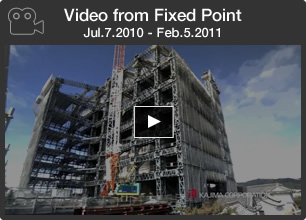More than 400 years have passed since the main keep of Himeji Castle (called “White Heron Castle” ) was built. This full scale restoration “Although this structure went through the major restoration work 45 years ago in the Showa era, it was showing age and damages and stains on plastered wall and eaves and canopies of the upper level needed another major repair work.” The “restoration for preservation in the Heisei era” focused on completely replacing the roof tiles on the main keep, or dai-tenshu, repairing the exterior great walls of the upper part of the castle, and replastering damaged or soiled boards behind the eaves or gables. In addition, partial dissection was conducted to reinforce the structures after verifying their strength.
- Location:
- Himeji city, Hyogo prefecture, Japan
- Total Floor Area:
- Approx. 2,409m2
- Eaves Height:
- Approx. 40.82m
- Maximum Height:
- Approx. 46.35m
- Main Keep:
- Wooden structure.
- Floors:
- 5 levels, 6 stories with basement.


Panoramic view of the major restoration in the Showa era, which was completed in 1964. (Courtesy of Himeji Center for Research into Castles and Fortifications)

Construction work at that time
![]()


Restoration schedule

The restoration for preservation in the Heisei era focused on replacing the roof tiles on the main keep and replastering damaged or soiled plaster walls. During this restoration period, the main keep was entirely covered by a roofed scaffold structure called “suyane.” This not only shelters the main keep from wind and rain after the tiles and plaster walls are removed, but also ensures a scaffold for reconstruction work. In addition, the observation space named “Tenku no Shirasagi (The White Heron in the Sky)” was set up within the suyane to allow the general public to view the restoration process.
To make preparations for installing the suyane, a steel gantry and a bridge were installed from Kisai-mon gate, which served as the entrance for construction vehicles, to the foot of the main keep to bring in steel beams and other building materials to the high main keep.

It seems to have 5 stories from outside. However, inside the castle has 6 floors to trick the incoming enemies.
Suyane
Height: 51.96 m
Number of stories: Temporary steel structure, 8 stories above the ground.
Footprint: 2,075 m2
(Observation space: 1,435 m2, restoration work area: 6,987 m2)
Harakiri-maru gantry
Height: 37.6 m Length: 66.0 m
Area: 924 m2
Kisai-mon gate bridge
Height: 1.8 m Length: 90.0 m
Temporary passageway: 670 m2




The roof tiles were entirely removed and reinstalled. After examining the type, size, place of use, and installation location of each of the approximately 80,000 tiles, they were removed. More than 80 percent of the roof tiles were washed and reused, and the number of newly created supplementary tiles amounted to about 16,000.
Full re-roof the main keep
(reuse of roofing tiles and production of supplementary tiles)
Sealing of roofing tiles and
installation of gauge laths
(reinforcement using nails or copper wire)
Full replastering of joint plaster
Plasters to hold the roof tiles were applied three times. Because of that, the castle looks much brighter after the repair.
Shachi-gawara
Ridge-end-tile with figure of a killer whale. A pair of Shachi-gawara was placed on the top of castle as an incantation against the fire.
Oni-gawara
Ridge-end-tile with the family symbol of successive loads.
For the external walls of the main keep, a rope was wrapped around the foundation of a wooden grid structure that was coated with thick mud and plaster. Over the years, the external walls had been damaged or become soiled. This restoration work focused on repairing the mud walls, replastering the surface of them, and replastering the edges of eaves, gables, and their decoration boards, and fittings.
Parts repaired
Behind the eaves: 2,780 m2
Internal and external walls: 2,200 m2
Mud-coated doors: 125 m2
Surface of internal walls: 1,173 m2
Repairing mud walls from the foundation
Internal and external walls: 403 m2
Mud-coated doors: 151 m2
Repairing the edges of eaves, gables, and their decoration boards
From the foundation: 495 m2
Repairing roof joints, etc.
From the foundation: 2,489 m2



The wooden parts were either replaced or grafted depending on the extent of damage or corrosion, and stamped with “restoration done.” In addition, damaged mud-coated doors and other parts were repaired and plaster parts were replastered. On top of these, the pillars, beams, and floors were reinforced without damaging the wood shafts, thereby increasing seismic capacity.












